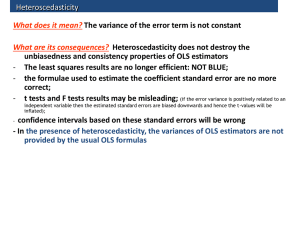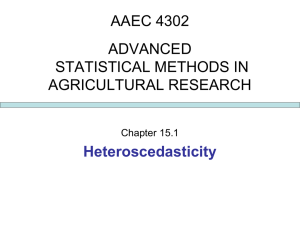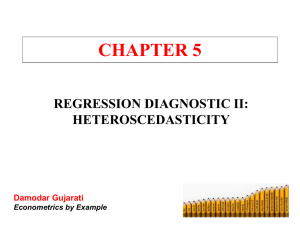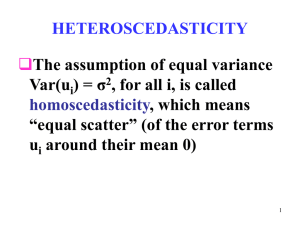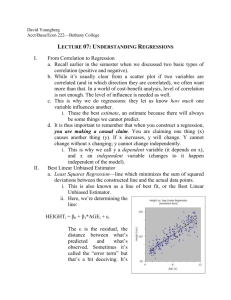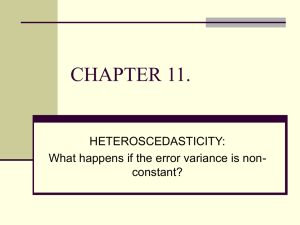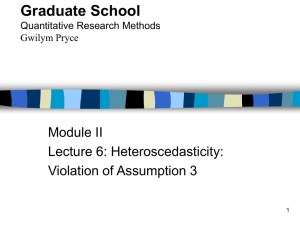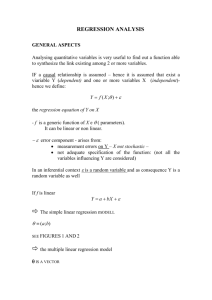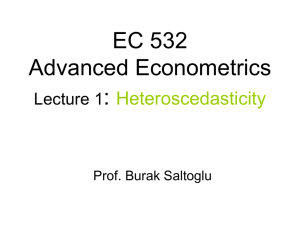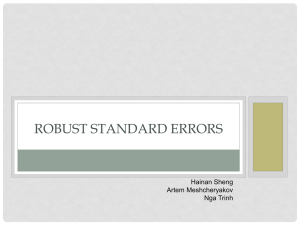CHAPTER
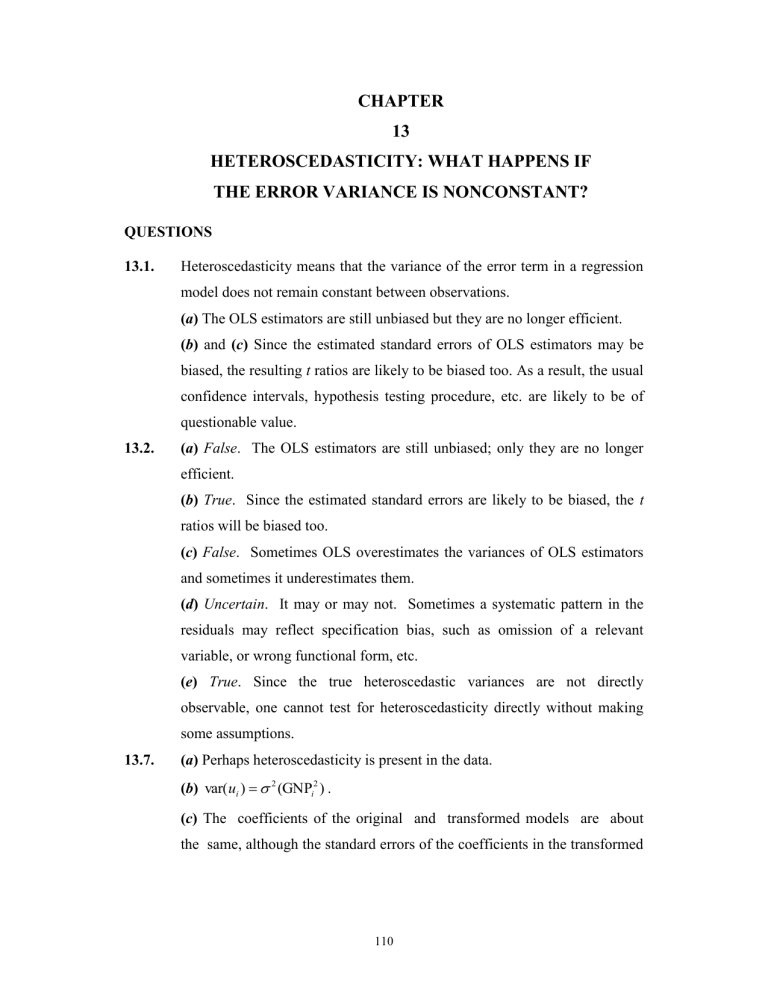
CHAPTER
13
HETEROSCEDASTICITY: WHAT HAPPENS IF
THE ERROR VARIANCE IS NONCONSTANT?
QUESTIONS
13.1. Heteroscedasticity means that the variance of the error term in a regression model does not remain constant between observations.
(a) The OLS estimators are still unbiased but they are no longer efficient.
(b) and (c) Since the estimated standard errors of OLS estimators may be biased, the resulting t ratios are likely to be biased too. As a result, the usual confidence intervals, hypothesis testing procedure, etc. are likely to be of questionable value.
13.2. (a) False . The OLS estimators are still unbiased; only they are no longer efficient.
(b) True . Since the estimated standard errors are likely to be biased, the t ratios will be biased too.
(c) False . Sometimes OLS overestimates the variances of OLS estimators and sometimes it underestimates them.
(d) Uncertain . It may or may not. Sometimes a systematic pattern in the residuals may reflect specification bias, such as omission of a relevant variable, or wrong functional form, etc.
(e) True . Since the true heteroscedastic variances are not directly observable, one cannot test for heteroscedasticity directly without making some assumptions.
13.7. (a) Perhaps heteroscedasticity is present in the data.
(b) var( u i
)
2
(GNP i
2
) .
(c) The coefficients of the original and transformed models are about the same, although the standard errors of the coefficients in the transformed
110
model seem to be somewhat lower, perhaps suggesting that the authors have succeeded in reducing the severity of heteroscedasticity.
(d) No. In the transformed model, the intercept in fact represents the slope coefficient of GNP.
R
2
(e) The two s cannot be compared directly because the dependent variables in the two models are different.
13.9.
(a) Because of earlier data errors, the regression results shown in equation
(13.30) in the text are not correct. Based on the data in Table 13-2, the results are as follows: l
ˆ n Y i
= -7.2822 + 1.3144 ln Sales i
se = (1.8615) (0.1692)
t = (-3.9120) (7.7674)
(b) The plots do not suggest strong heteroscedasticity.
(c) Park Test : l
ˆ n e i
2
= -17.5539 + 6.6255 ln( ln Sales i
) r
2
= 0.7904 t = (-1.8161) (1.6387) r
2
= 0.1437
Note : The original regression is double-logarithmic. Therefore, in the Park test we are using the natural log of the squared residuals and the natural log of ln Sales .
Since the slope coefficient in this regression is not statistically significant at the 5% level, the Park test does not suggest the presence of heteroscedasticity.
Glejser Test : | e i
| = -1.0771 + 0.1513 ln Sales i t = (-1.0700) (1.6534) r
2
= 0.1459
This particular form of the Glejser test suggests that there is no heteroscedasticity.
(d) In the present case, the question is academic.
(e) Perhaps the log-linear model.
(f) No, because the dependent variables in the two models are not the same.
13.11. (a) Let Y = GDP growth rate (%), and X =
Investment
GDP
(%).
111
You can regress Y on X . You can also regress ln Y on ln X , provided the Y values are positive. To make all the Y values positive, add a constant in such a way that the largest negative value becomes positive.
(b) Yes, there is evidence of heteroscedasticity. This should not be surprising because the countries in the sample have positive as well as negative real interest rates.
(c) If it is assumed that the error variance is proportional to the value of X , use the square root transformation. If it is assumed that the error variance is proportional to the square of X, divide the equation by X on both sides.
(d) Add two dummy variables to the model to distinguish the three categories of interest rate experiences. If the original model (without the dummies) was mis-specified, and if the residuals in the new model (i.e., with the dummies added) do not exhibit any systematic pattern, the
“heteroscedasticity” observed in the original model can then be attributed to the mis-specification bias.
13.14. (a) Yˆ i
= 1,993.7258 + 0.2328
X i t = (2.1309) (2.3340)
(b)
Y i
i
= 2,417.3347
1 i
+ 0.1800
X i
i
2 r = 0.4376 t = (2.1131) (1.4273)
2 r = 0.6482
Note : This
2 r is the one generated by EViews . Since the regression does not have an intercept, you may wish to calculate the raw
2 r as an exercise.
In this example, the unweighted regression may be more appropriate based on the statistical significance of the coefficients.
13.16. (a) In regression (1) the slope coefficient suggests that if the number of employees increases by 1, the average salary goes up by 0.009 dollars.
After multiplying through by N , the slope coefficient in model (2) is about the same as in model (1).
(b) The author is not only assuming heteroscedasticity, but specifically states that the error variance is proportional to the square of N .
112
(c) As noted in ( a ), the two slopes and the two intercepts are about the same.
(d) Because the two dependent variables are not the same, the two R
2 s cannot be compared directly.
113
